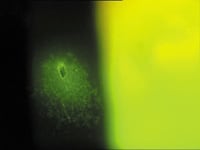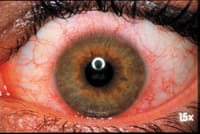HIGH-DK/T MATERIALS
Benefits and Challenges of High-Dk/t Materials
Silicone hydrogels offer many benefits compared to low-Dk hydrogel lenses, but complications still occur.
By Desmond Fonn, Dip Optom, M Optom, FAAO, and Alisa Sivak, BA, DipEd, MA
Conventional low-Dk/t hydrogel lenses provide less-than-optimal amounts of oxygen to the eye, particularly during extended wear (EW). The resulting hypoxia compromises ocular health and may manifest in a variety of forms including corneal swelling, limbal and bulbar hyperemia, corneal neovascularization, refractive changes and epithelial microcysts. Although high-Dk/t silicone hydrogel lenses have eliminated or minimized these complications, as we'll see in the following sections, they still cause adverse events -- most of which have a mechanical or inflammatory etiology.
Silicone Hydrogel Benefits
Less Corneal Swelling Studies have found that overnight corneal swelling without lenses ranges from 1.5 percent to 5.5 percent, with the majority around 3.0 percent to 3.5 percent. Studies conducted at the Centre for Contact Lens Research (CCLR) in Waterloo have clearly demonstrated that silicone hydrogel lens wear significantly reduces overnight central corneal swelling to about the same amount (approximately three percent) as no lens wear and significantly less than that with low-Dk/t hydrogel lenses (seven percent to nine percent).
Reduced Limbal and Bulbar Hyperemia Eyes wearing high-Dk/t lenses consistently exhibit significantly less limbal and bulbar hyperemia (Brennan, 2002; Dumbleton, 2001) at levels that tend to stay constant compared to eyes wearing low-Dk/t lenses, which may increase in redness over time. In fact, researchers who conducted clinical studies over a three-year period found that limbal redness decreased even lower than baseline levels with the continuous wear (CW) of high-Dk/t lenses (Coles et al, 2001).
Decreased Neovascularization Studies conducted at the CCLR in Waterloo and the Vision CRC in Sydney, Australia have found that high-Dk/t lens wear causes significantly less neovascularization compared with low-Dk/t lens wear. In the Vision CRC, researchers refit study participants who wore low-Dk/t disposable soft contact lenses with high-Dk/t lenses and discovered an emptying of blood vessels over time. They suggested the use of silicone hydrogel lenses particularly for patients who have high refractive errors and are prone to develop neovascularization from the combination of increased peripheral lens thickness and low-Dk/t hydrogel materials.
|
|
|
| Figure 1. Localized CLPC. | |

|
|
| Figure 2. Superior epithelial arcuate lesion. | |

|
|
| Figure 3. A small corneal erosion surrounded by diffuse epithelial staining. (Courtesy of Kathy Dumbleton.) | |

|
|
| Figure 4. A typical CLARE reaction. |
Myopia Regression For years, we've known that low-Dk/t hydrogel lenses cause an increase in myopia. More recent studies of CW with high-Dk/t lenses show no increase in myopia compared to a significant shift with EW of low-Dk/t lenses. Dumbleton at the CCLR has shown how myopia regresses when participants who have worn low-Dk/t hydrogels switch to silicone hydrogels and wear the lenses on a 30-night CW cycle.
Fewer Epithelial Microcysts Researchers have long considered epithelial microcysts as an excellent marker of chronic hypoxia. These small, irregular-shaped inclusions that usually occur in the paracentral zones of the cornea occasionally occur with daily wear (DW) or spectacle wearers (less than 10), but significant numbers of microcysts most commonly result from EW of low-Dk/t lenses. Masked studies comparing EW of low- and high-Dk/t lenses show significantly less epithelial microcysts with CW of high-Dk/t materials, similar to levels seen without contact lenses or with DW of low-Dk/t lenses.
Other Effects of Contact Lens Wear on the Epithelium One concern of contact lens wear is that the lens affects the epithelium and Pseudomonas aeruginosa bacteria bind to the damaged epithelial cells. It appears that P. aeruginosa bind more readily to cells that have experienced hypoxia with low-Dk/t hydrogel lens wear than they do during high-Dk/t silicone hydrogel lens wear. The implication of these findings is that wearing silicone hydrogels will lessen the risk of developing microbial keratitis (MK). However, certain strains of P. aeruginosa can penetrate normal epithelial cells without initial attachment to the cell wall, serving as another potential mechanism of corneal infection.
Ladage (2002) has also demonstrated that EW of low-Dk/t hydrogel lenses in human trials causes thinning of the central epithelium over time, whereas no thickness changes occurred with high-Dk/t silicone hydrogel lens wear for both six and 30 nights EW.
Silicone Hydrogel Challenges
Despite the significant benefits of higher oxygen transmissibility, some complications still occur with high-Dk silicone hydrogel lenses. These challenges fall into three categories: mechanical complications, inflammatory events and corneal infections.
Mechanical Complications:
* Contact Lens Papillary Conjunctivitis (CLPC) Though this complication can result from an immunologic response to denatured protein deposits on a lens surface, in the case of silicone hydrogels, it's more likely in response to stiffness, edge or surface properties, which is why we classify it as a mechanical cause. The onset can occur fairly quickly, and it's not uncommon to observe a localized CLPC with silicone hydrogels (Figure 1) as opposed to the more common hydrogel lens-induced CLPC that affects the entire tarsal plate. The incidence of this condition in the early silicone hydrogel clinical trials was approximately six percent, but the incidence appears to have decreased with newer additions to the market and improved lens designs.
* Superior Epithelial Arcuate Lesions (SEAL) SEALs are arc-like lesions that usually develop on the superior cornea and span an area of 1mm to 3mm from the limbus (Figure 2). They don't usually produce symptoms. Localized limbal hyperemia and infiltration may sometimes accompany a SEAL, but they're invariably unilateral. The incidence of this condition also varies considerably. Our (CCLR) early trials found an incidence of six percent to eight percent, but anecdotal reports suggest that the incidence is now lower.
* Corneal Erosions This condition occurs infrequently with silicone hydrogels, more so with CW than DW. It may be a surface-activated phenomenon in which the contact lens temporarily adheres to the epithelium upon waking, causing trauma when the lens moves with little post-lens tear film thickness (Figure 3). Symptoms can include some pain that increases upon lens removal, limbal and/or bulbar hyperemia, tearing and photophobia.
* Mucin Balls These become trapped between the corneal epithelium and the back surface of the contact lens during eye closure. They likely result from the lens "shearing" thin layers of the tear film, which then roll into small balls with the movement of the eye under-surface of the lens. Easily blinked away after lens removal, mucin balls tend to leave depressions -- not abrasions -- on the epithelial surface. The use of rewetting drops before and after sleep may reduce the number of mucin balls. They aren't associated with any adverse effects.
Inflammatory Events:
* Contact Lens Acute Red Eye (CLARE) This acute inflammatory reaction (Figure 4) is associated with overnight lens wear, and patients typically report that severe ocular discomfort woke them from sleep. The incidence of this condition varies considerably but it doesn't appear to differ from the incidence of CLARE with low-Dk/t hydrogel lenses worn on an EW basis. The condition most likely results from Gram-negative bacteria and the toxins they release.
* Contact Lens Peripheral Ulcer (CLPU) CLPUs have earned their name because, in the active phase, they always include an overlying frank epithelial defect with an underlying infiltrate. This events should be distinguished microbial infections. CLPU incidence is difficult to quantify because different names, such as sterile infiltrates or peripheral corneal infiltrates, describe the same condition. The incidence of CLPUs from silicone hydrogel lens CW ranges from two percent to 14 percent, but it's less with DW. The incidence of this condition with silicone hydrogels is probably much the same as it is with low-Dk/t hydrogel lenses.
* Infiltrative Keratitis (IK) As with CLARE and CLPU, IK is a significant adverse event. Asymptomatic infiltrative keratitis (AIK) is distinct from IK in that patients are asymptomatic and the condition is less severe. To simplify matters, we'll include both types as they relate to silicone hydrogels. Both include the presence of focal and/or diffuse and mild to moderate infiltrates in the cornea (usually peripheral), usually with segmented limbal hyperemia. These infiltrative conditions may have mild superficial overlying epithelial staining. Their incidence with silicone hydrogels appears slightly higher than CLARE and CLPUs.
Corneal infections MK does occur with silicone hydrogel lenses, which should come as no surprise to any practitioner. However, the precise rates compared to the known rates with conventional DW (approximately 1/5,000) and EW (1/500) of hydrogel lenses remains unknown. The number of reports from the siliconehydrogel.org Web site suggests that the rate for EW of silicone hydrogels ranges from one in 4,000 to one in 10,000. The post market surveillance studies that CIBA Vision and Bausch & Lomb are conducting in the United States and two known international epidemiological studies that are currently underway should confirm the incidence of this complication toward the end of 2005. Anecdotal reports suggest that the infections from silicone hydrogel lens wear aren't as severe as those associated with EW of conventional hydrogel lenses.
Daily Wear Silicone Hydrogel Complications
Recent studies have found that some multipurpose solutions (MPS) are incompatible with some silicone hydrogel materials, causing asymptomatic corneal staining. This superficial but diffuse, peripherally dominant epithelial staining doesn't occur with
hydrogen peroxide systems or Polyquad-preserved solutions. New MPS formulations should also eradicate this complication.
Conclusion
Silicone hydrogel lenses have essentially eliminated the hypoxic effects of contact lens wear. Although some complications (those that are mechanically induced) seem to be decreasing, further work is necessary to minimize adverse events.
To obtain references, visit www.clspectrum.com/references.asp and click on document #112.

|
Dr. Fonn is Director of the Centre for Contact Lens Research, Professor, School of Optometry, Waterloo. |

|
Ms. Sivak is the Communications Coordinator of the Centre for Contact Lens Research, School of Optometry, University of Waterloo. |




